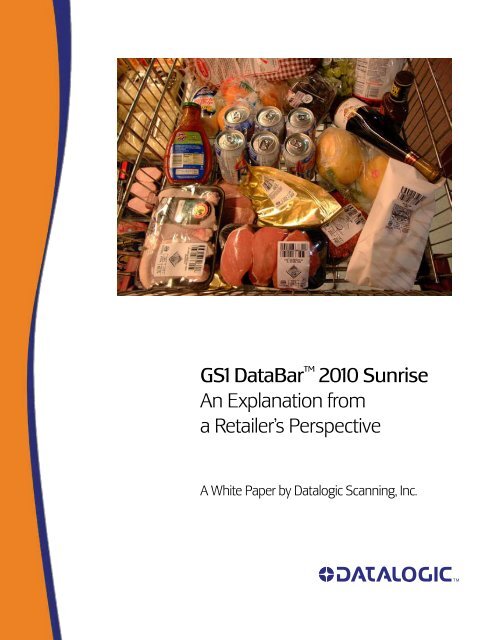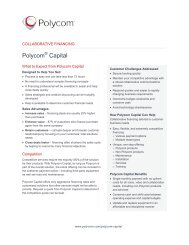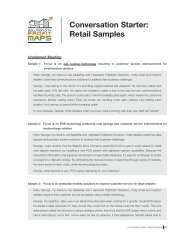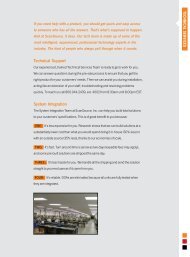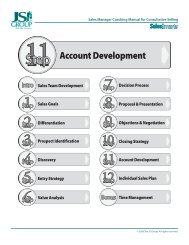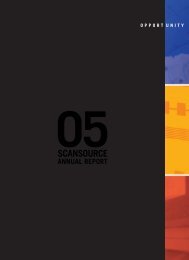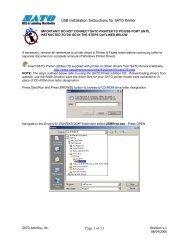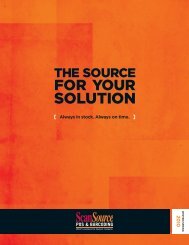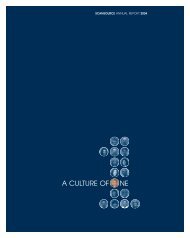Datalogic - ScanSource
Datalogic - ScanSource
Datalogic - ScanSource
Create successful ePaper yourself
Turn your PDF publications into a flip-book with our unique Google optimized e-Paper software.
GS1 DataBar TM 2010 Sunrise<br />
An Explanation from<br />
a Retailer’s Perspective<br />
A White Paper by <strong>Datalogic</strong> Scanning, Inc.
Copyright © <strong>Datalogic</strong> Scanning, Inc. 2008. All rights reserved. • Protected to the fullest extent under U.S. and international<br />
laws. Copying, or altering of this document is prohibited without express written consent from <strong>Datalogic</strong> Scanning, Inc.<br />
<strong>Datalogic</strong> Scanning, Inc. of Eugene, Oregon, USA is ISO registered by NQA.<br />
Magellan, PowerScan, and QuickScan are registered trademarks of <strong>Datalogic</strong> Scanning, Inc. <strong>Datalogic</strong> is a registered trademark of <strong>Datalogic</strong><br />
S.p.A. in many countries and the <strong>Datalogic</strong> logo is a trademark of <strong>Datalogic</strong> S.p.A. Catcher, Diamond, Dragon, FireScan, Gryphon, Heron,<br />
Lynx, Touch are trademarks of <strong>Datalogic</strong> S.p.A. All other brand and product names are trademarks of their respective owners.<br />
Information on <strong>Datalogic</strong> products and services, and electronic, downloadable versions of this document are located on the <strong>Datalogic</strong> web<br />
site: www.scanning.datalogic.com. • Please contact your <strong>Datalogic</strong> Scanning, Inc. Representative.<br />
Reasonable measures were taken to ensure that the information provided is complete and accurate at the time of publication. However,<br />
<strong>Datalogic</strong> reserves the right to change any product specification at any time without prior notice.<br />
Please visit our web site at: www.scanning.datalogic.com for the most up-to-date version. Reasonable measures were taken to ensure that<br />
information taken from other sources was correct at the time of publication. <strong>Datalogic</strong> Scanning, Inc. is not responsible for errors of omission<br />
or inaccuracies, as material becomes dated shortly following publication.
GS1 DataBar TM 2010 Sunrise<br />
An Explanation from a Retailer’s Perspective<br />
Introduction<br />
A new type of bar code, GS1 DataBar TM , has been approved for marking trade items in the retail supply chain. GS1, the<br />
global retail standards-setting organization formerly known as EAN International and Uniform Code Council, has set<br />
January 1, 2010 as the “sunrise” mandate for global adoption of this new bar code type.<br />
As of 2010 all manufacturers, worldwide, will have the option of marking their packages with GS1 DataBar TM codes –<br />
as an alternative to the EAN/UPC bar codes used today. Retailers must be ready to scan these packages at the pointof-sale<br />
and elsewhere within their logistics systems.<br />
This change is a critical step that enables future standards improvements for several important retail applications,<br />
such as coupons and marking of fresh foods.<br />
That’s the essence of the 2010 Sunrise mandate. Read onward for the details.<br />
GS1 DataBar TM 2010 Sunrise Requirements<br />
GS1 announced the 2010 Sunrise with two press releases, excerpted here:<br />
BRUSSELS, Belgium, June 12, 2006 – GS1, a not-for-profit standards organization, today announced a global<br />
sunrise date of Jan 1, 2010 for a new bar code called Reduced Space Symbology (RSS)... The adoption date<br />
of 2010 sets the goal for bar code systems to be capable of scanning RSS bar codes and processing GS1<br />
Application Identifiers…<br />
BRUSSELS, Belgium, February 27, 2007 – GS1 announced today the adoption of the name “GS1 DataBar TM ” for its<br />
new Bar Code, in replacement of the previously used “RSS” (Reduced Space Symbology), as the symbol enters<br />
the broad adoption phase…<br />
For retailers there are two requirements for meeting the 2010 sunrise mandate:<br />
1. All retail systems that scan trade item bar codes must be capable of scanning the new family of GS1<br />
DataBar TM codes, which encode the same data (the Global Trade Item Number or GTIN) as encoded in EAN/<br />
UPC bar codes today.<br />
2. And scanning systems must be capable of recognizing additional types of data possibly encoded in GS1<br />
DataBar TM codes, such as weight, price, and expiration date, which are identified with GS1 Application<br />
Identifiers (AIs).<br />
Note that this is a global initiative. GS1 is a global organization with over 100 member organizations spread around<br />
the world, and over a million supplier/retailer members. Starting in 2010, trading partners across the globe will be<br />
printing and reading the new GS1 DataBar TM codes.<br />
Also note that GS1 DataBar TM is intended for marking trade items only, not for marking other logistics items such as<br />
cases and pallets. Existing GS1 authorized solutions such as the ITF and GS1-128 bar codes will continue to be used<br />
for marking cases and pallets.<br />
GS1 DataBar TM 2010 Sunrise | An Explanation from a Retailer’s Perspective Page – 1
Why Change Now?<br />
The GS1 standard for marking trade items, centered around EAN/UPC bar codes, has been evolving for over 30 years.<br />
As described below, there are several retail application systems that worked well ten or twenty years ago, but which<br />
are no longer robust enough to meet today’s business needs. After extensive research and discussion, a GS1-led task<br />
force of business leaders from both retailing and manufacturing companies concluded that it is time for the industry<br />
to take this major step. The adoption of GS1 DataBar TM builds the foundation for addressing many limitations with<br />
current retail systems.<br />
In the following list of applications, only the first is mandated by the GS1 DataBar TM 2010 Sunrise. The adoption of GS1<br />
DataBar TM will enable future standards updates for the remaining applications.<br />
Small Packaged Trade Items<br />
• Problem: It is difficult to place a bar code that is easily<br />
readable on very small items. The EAN-8 and UPC-E<br />
bar codes are intentionally smaller and intended for<br />
marking small items, but there are a limited number of<br />
values possible with only eight digits. This forces many<br />
manufacturers to use very truncated forms of EAN-13<br />
and UPC-A bar codes, which are difficult for point-ofsale<br />
scanners to read.<br />
TM<br />
• Solution: GS1 DataBar is capable of encoding a full<br />
GTIN in about half the space required by EAN-13 and<br />
UPC-A bar codes. Starting in 2010 manufacturers are<br />
enabled and expected to switch to GS1 DataBar TM for<br />
marking many of their products, small and large.<br />
Fresh Produce<br />
• Problem: With increased consumer interest in an<br />
expanding variety of fresh produce, it is increasingly<br />
important that such products be unambiguously<br />
identified. Stickers with Price Look-up (PLU) numbers help,<br />
but there aren’t enough PLU values to go around, and<br />
PLU numbers don’t identify the source of the produce.<br />
TM<br />
• Solution: GS1 DataBar codes can be printed to fit on a produce sticker. A full GTIN is encoded, which<br />
means the product type can be specified unambiguously, and the supplier uniquely identified.<br />
Variable-Measure Fresh Foods<br />
• Problem: The existing Number System 2 UPC-A bar codes used to mark variable weight packages (such as<br />
meat and deli) provide the price, but suffer the same problems seen in fresh produce – neither the precise<br />
product type nor the manufacturer can be captured in the bar code.<br />
TM<br />
• Solution: The GS1 DataBar family includes bar codes that can encode much more than just a GTIN. For<br />
variable-measure foods, for example, the GS1 DataBar TM could encode a GTIN, the weight, the price, and<br />
a sell-by date. Now the full product and manufacturer identification are provided, as well as additional<br />
essential information that will support compliance with the expected FDA requirements for food tracking<br />
and traceability in the grocery retail sector.<br />
Page – 2<br />
A White Paper by <strong>Datalogic</strong> Scanning, Inc.
Coupons<br />
• Problem: The Number System 5 UPC-A coupon<br />
codes issued in North America are also showing<br />
their age. Among many limitations are the inability<br />
to fully identify the issuer of the coupon and the<br />
restriction to only 100 specific purchase requirement<br />
and cents off combinations.<br />
TM<br />
• Solution: The GS1 DataBar is capable of encoding<br />
up to 70 digits of information, and a coupon<br />
re-engineering committee has defined a very<br />
robust coupon solution that uses GS1 DataBar TM<br />
to overcome all of the limitations with the current<br />
system.<br />
Scan-Based Trading<br />
• Problem: Retailers with Scan-Based Trading<br />
relationships with suppliers of periodicals and<br />
books today often read UPC-A bar codes with<br />
accompanying 2 and 5 digit add-ons. Although<br />
modern scanners handle this pretty well, there are<br />
concerns about capture rate of the add-ons and scanning performance degradation.<br />
• Solution: GS1 DataBar TM symbols can be defined to contain both the GTIN value and the add-on value in a<br />
single bar code. This completely eliminates the performance and capture rate concerns of the current system.<br />
Pharmacy and Small Health Care Items<br />
• Problem: Currently small<br />
medication packages and health<br />
care items are marked with very<br />
truncated, hard to read bar codes<br />
(of various symbologies) or not<br />
marked at all (increasing the risk of<br />
incorrect patient delivery).<br />
• Solution: The smaller versions of<br />
GS1 DataBar TM are already being<br />
adopted for these small items,<br />
as is Data Matrix, a 2D matrix<br />
symbology. But contrary to all the<br />
other examples described here,<br />
these bar codes are not suitable for<br />
reading at the point-of-sale.<br />
We’ve reviewed six reasons why GS1 (and the retailers and manufacturers it supports) feel the urgent need to<br />
enhance the current system of retail standards. Without the universal and global commitment to GS1 DataBar TM ,<br />
these six problems will remain unsolved.<br />
GS1 DataBar TM 2010 Sunrise | An Explanation from a Retailer’s Perspective Page – 3
It’s very important to note, however, that<br />
the 2010 Sunrise date does not require<br />
retailers to do anything new in handling fresh<br />
produce, variable-measure foods, coupons,<br />
or Scan-Based Trading data. Adoption of GS1<br />
DataBar TM for these applications will occur<br />
over time when workgroups in the four areas<br />
release standards, and only when retailers<br />
decide it makes business sense to change. The<br />
status of these application standards efforts is<br />
presented later in this paper.<br />
To reiterate, starting in 2010 manufacturers<br />
are authorized to mark their retail packages<br />
with GS1 DataBar TM codes. Therefore, by 2010<br />
retailers must ensure that all point-of-sale<br />
scanners (and any other scanners that scan<br />
trade items) are capable of and enabled to<br />
read GS1 DataBar TM codes. And they must<br />
verify that these scanners are also capable of reading and delivering the additional AI-based information that may be<br />
encoded on future DataBar TM codes. That’s it. Nothing more.<br />
A Word About GTINs and Application Identifiers<br />
The Global Trade Item Number (GTIN) provides unique identification for every trade item in the global supply chain.<br />
A box of cereal from General Mills has a different GTIN than a box of similar private label cereal. But fresh foods are<br />
different. Since they aren’t marked with GTINs today, there is no automated way to differentiate a banana from Del<br />
Monte from a banana from Dole.<br />
The GTIN has two main components – the Company Prefix of the manufacturer (assigned to it by GS1) and an Item<br />
Reference Number assigned by the manufacturer. Every bar code on a trade item encodes a GTIN. But different bar<br />
code types have different capacities, so GTINs come in various lengths.<br />
Bar Code Symbology Capacity GTIN Type<br />
UPC-A 12 GTIN-12<br />
UPC-E 8 GTIN-12<br />
EAN-13 13 GTIN-13<br />
EAN-8 8 GTIN-8<br />
GS1 DataBar TM 14++ GTIN-14<br />
Since the Uniform Code Council 2005 Sunrise, all North American retailers have been capable of reading, storing<br />
and processing of GTIN-8, GTIN-12, and GTIN-13 identifiers. (Retailers in the rest of the world have always had this<br />
capability.) Although it was highly recommended by the UCC at the time, there is no assurance that retailers have<br />
upgraded their systems to handle the GTIN-14.<br />
Thus it is important to point out that the 2010 Sunrise does not require retailers to accept GTIN-14. Although the GS1<br />
DataBar TM can encode the GTIN-14, it can also encode GTIN-8, GTIN-12, and GTIN-13. 2010 Sunrise specifically prohibits<br />
the encoding of GTIN-14 in GS1 DataBar TM until such later time as trading partners agree to it.<br />
Page – 4<br />
A White Paper by <strong>Datalogic</strong> Scanning, Inc.
The GTIN is just one of over 100 Applications Identifiers (AIs)<br />
defined in GS1 global trading standards. Each AI consists<br />
of a two to four digit identifier, followed by multiple digits<br />
of data. For example, the GTIN has a two-digit identifier<br />
of “01” and 14 digits of data. AIs are either keys (like trade<br />
item or location) or attributes of those keys (like serial<br />
number, lot number, weight, price). The set of AIs as a<br />
whole forms a consistent “data dictionary” used across<br />
multiple GS1 systems, including bar codes, EPC tags, Data<br />
Synchronization, and Electronic Commerce.<br />
Variations of the GS1 DataBar TM<br />
GS1 DataBar TM is really a family of bar code symbologies.<br />
Some are very small, intended for produce and small<br />
consumer packages. And some are larger, intended to<br />
carry more data needed for identifying variable-measure<br />
foods and the required content on coupons.<br />
Variant Capacity POS Potential Applications Sample<br />
GS1 DataBar TM<br />
Omnidirectional<br />
GS1 DataBar TM Stacked<br />
Omnidirectional<br />
16 digits Yes Packaged goods<br />
16 digits Yes Produce, packaged<br />
goods<br />
GS1 DataBar TM Expanded Up to 74<br />
digits<br />
Yes<br />
Variable-measure food,<br />
Coupons<br />
GS1 DataBar TM Expanded<br />
Stacked<br />
Up to 74<br />
digits<br />
Yes<br />
Variable-measure food,<br />
Coupons<br />
GS1 DataBar TM Truncated 16 digits No Health care items<br />
GS1 DataBar TM Stacked 16 digits No Health care items<br />
GS1 DataBar TM Limited 16 digits No Health care items<br />
Note that the capacity numbers above include the AI identifier digits as well as data digits. (The GTIN consists of a<br />
two-digit AI identifier and 14 data digits.) Only the four variants marked “Yes” under POS are designed for reading at<br />
the point-of-sale. The other three variants are not authorized by 2010 Sunrise for any retail uses.<br />
Size Matters<br />
Two major advantages of GS1 DataBar TM over the current EAN/UPC symbols are that GS1 DataBar TM can encode the<br />
same amount of data in a smaller space, or it can encode more data in the same space as EAN/UPC, as shown in<br />
the following illustration.<br />
GS1 DataBar TM 2010 Sunrise | An Explanation from a Retailer’s Perspective Page – 5
EAN-13 encoding a GTIN<br />
EAN-13<br />
Symbol<br />
Area<br />
GS1 DataBar TM encoding a<br />
GTIN<br />
GS1 DataBar TM Omnidirectional<br />
GS1 DataBar TM Stacked<br />
Omnidirectional<br />
GS1 DataBar TM encoding a<br />
GTIN and Serial Number<br />
(01)00212345834565<br />
GS1 DataBar TM Expanded<br />
(01)00212345834565<br />
GS1 DataBar TM Expanded Stacked<br />
01900123456789152111122233<br />
01900123456789152111122233<br />
GS1 DataBar TM – A Brief History<br />
Up to now we’ve talked about what GS1 DataBar TM is, but how did it come to be? In the early 1990s the Uniform<br />
Code Council’s Symbology Technology Advisory Committee (STAC) started searching for solutions to the variablemeasure<br />
fresh foods problem. They considered solutions with existing EAN/UPC and UCC/EAN-128 bar codes, but<br />
none were acceptable in terms of performance<br />
at the point-of-sale. The decision was made<br />
to invest in a new bar code symbology that<br />
could encode more data in less space without<br />
degradation of performance at the point-of-sale.<br />
The Technical Symbology Committee (TSC) of AIM<br />
Global was asked to lead the design of this new<br />
symbology, with the real work contracted to Ted<br />
Williams, an expert symbology designer. After a<br />
lot of hard work involving AIM’s TSC, UCC’s Global<br />
Symbology Committee (GSC, formerly STAC), and<br />
bar code solution providers (including <strong>Datalogic</strong><br />
Scanning), the complete specification for a new<br />
Reduced Space Symbology (RSS) was released<br />
as an AIM specification in October of 1999. In the<br />
years since then no significant problems have<br />
been found with the symbology, and bar code solution providers have implemented it in most of their current products.<br />
Page – 6<br />
A White Paper by <strong>Datalogic</strong> Scanning, Inc.
In 2007 GS1 changed the name of RSS to GS1<br />
DataBar TM . This was done to reduce confusion<br />
with other uses of the acronym RSS and to better<br />
emphasize the important advantages of this new<br />
symbology beyond simply reducing space. Today<br />
more than 60% of installed retail scanners are<br />
capable of reading GS1 DataBar TM codes, and GS1<br />
expects that number to exceed 85% by 2010.<br />
Where Does RFID Fit?<br />
There’s a lot of talk about RFID and EPC (Electronic<br />
Product Code) from EPCglobal. Is the adoption of GS1<br />
DataBar TM really necessary? Or should we just wait for<br />
RFID?<br />
The answer is that both new technologies are coming<br />
and both are critical, but for different reasons. Driven<br />
by Wal-Mart and others, EPC tags will increasingly be seen on cases and pallets traveling the supply chain. EPC tags may<br />
even be seen at the retail point-of-sale on unique categories of products – large expensive items (TVs), some types of<br />
clothing, video rentals, etc.<br />
But bar codes are not going to disappear from the vast bulk of retail trade items. They are an inexpensive and wellestablished<br />
solution. But they are getting a little old. The GS1 DataBar TM 2010 Sunrise provides a much-needed boost to<br />
ensure that bar codes remain the most cost effective way to meet business needs across a wide range of retail applications.<br />
GS1 is integrating EPC and bar codes into their unified system of standards. Both data carriers encode Application<br />
Identifiers, so both can be used to convey the same information. Indeed, GS1 DataBar TM codes can serve to backup<br />
the information contained in EPC tags.<br />
Initiatives and Applications for GS1 DataBar TM<br />
As described earlier, there are six major applications to which GS1 DataBar TM will be applied. Only one, packaged<br />
goods, is required to be in place by the 2010 Sunrise date. The others will be phased in after completion of initiatives<br />
defining their respective requirements. The status of these initiatives is described here.<br />
Packaged Goods<br />
Current status: Fixed-weight packaged goods is the simplest application for GS1 DataBar TM . Starting in 2010<br />
manufacturers around the globe are permitted to mark their packages with GS1 DataBar TM codes encoding a GTIN-8,<br />
GTIN-12, or GTIN-13. These data structures are already universally understood and processed by retailers.<br />
Impact: The only change is that retailers must have readers capable of reading GS1 DataBar TM , and GS1 DataBar TM<br />
must be enabled for reading on every point-of-sale scanner, as well as any other readers in the supply chain used to<br />
read trade items.<br />
Benefits: A primary benefit goes to manufacturers, who may now utilize a smaller bar code to mark smaller packages<br />
or to leave more room for product information on larger packages. But there is also a large benefit for retailers, since<br />
manufacturers will be less likely to mark their packages with small out-of-spec EAN/UPC labels, which noticeably<br />
reduce productivity at the point-of-sale.<br />
GS1 DataBar TM 2010 Sunrise | An Explanation from a Retailer’s Perspective Page – 7
Fresh Produce<br />
Current status: Several initiatives are<br />
currently underway at major retailers to<br />
demonstrate the feasibility of marking<br />
fresh produce with GS1 DataBar TM codes.<br />
This requires coordinating with suppliers<br />
to add the bar code to their PLU stickers.<br />
The stickers will continue to include the<br />
current PLU number in addition to the<br />
new bar code. Thus a retailer is not forced<br />
to change, and can decide to switch<br />
to GS1 DataBar TM for produce in the<br />
timeframe that works best for it.<br />
Impact: Converting from PLU numbers<br />
to GS1 DataBar TM codes will require some<br />
store system upgrades. There will be a<br />
change in the scan/weigh cycle at the point-of-sale. But more significantly, the produce bar codes will not encode the<br />
current PLU number. Rather, they will encode a GTIN, which includes the unique Company Prefix of the supplier and an<br />
Item Reference number selected by the supplier. Different suppliers that provide the same commodity produce item<br />
will have different GTINs, even though the PLU number for their two produce items would be the same. The retailer<br />
will likely create a many-to-one database relationship between the new supplier GTINs and the current PLU numbers.<br />
This will add to the number of distinct products in the retailer’s system and perhaps complicate ordering processes.<br />
Benefits: Despite the work required by retailers to adopt GS1 DataBar TM for fresh produce, the benefits should be<br />
substantial. Just as is currently true for packaged goods, produce sales will be accurately tracked. There will be no<br />
shrinkage due to miss-identified items, which often happens if there are several similar products that look the same,<br />
especially in identifying organic produce. Current inventory will be more accurately measured. Meaningful category<br />
management will now be possible.<br />
Recalls limited to specific suppliers will<br />
be practical. Self-checkout customers will<br />
appreciate scanning bar codes, which is<br />
easier than entering PLU numbers.<br />
Variable-Measure Fresh Foods<br />
Current status: An association of US<br />
trade organizations representing the<br />
various categories of fresh foods has<br />
issued a white paper encouraging their<br />
members to adopt GS1 DataBar TM for<br />
marking all types of variable-measure<br />
foods – meat, poultry, fish, deli, bakery,<br />
etc. A few retailers have completed pilot<br />
tests utilizing GS1 DataBar TM Expanded<br />
labels encoding the supplier’s GTIN,<br />
weight, price, and sell-by date.<br />
Page – 8<br />
A White Paper by <strong>Datalogic</strong> Scanning, Inc.
Currently GS1 is sponsoring a global Fresh Foods Identification Work Group, with the goal of defining a worldwide<br />
standard for identification and marking of variable-measure foods. The group has gathered requirements, and they<br />
are now working on a business case to justify upgrading to a new solution.<br />
Impact: Due to the 2010 Sunrise mandate, retailers will have the capability of reading GS1 DataBar TM codes, including<br />
various Applications Identifiers, within their stores. Relatively small changes will be required to a store’s application<br />
software to deal with a different format for item identification and price. More work, as described above for fresh<br />
produce, will be required to map the GTIN identification to the existing structure of PLU numbers. And additional<br />
software will be required to take advantage of new information encoded in the GS1 DataBar TM , such as sell-by date<br />
and lot number.<br />
Benefits: Each category of variable-measure foods has a limited number of PLU numbers to assign to an expanding<br />
number of distinct products. Migration to GTIN-based identification will allow an unlimited number of innovative<br />
products to be uniquely identified. And GTINs unambiguously identify the source of the product, greatly enhancing<br />
traceability. Automated checking of sell-by dates will prevent sale of outdated products. Very accurate data will be<br />
available for category management and shrink control.<br />
Coupons<br />
Current status: In 2003 GS1 US and the Joint Industry Coupon Committee (JICC) sponsored a coupon re-engineering<br />
project, which resulted in a detailed specification for GS1 DataBar TM -based coupons, which is being adopted today.<br />
Several tests have been completed to demonstrate the feasibility and performance of the new solution. A phased<br />
rollout is starting in which the initial change is to a coupon format that includes both the current UPC-A bar code<br />
and a new GS1 DataBar TM Expanded code. Since retailers read only the UPC-A bar code, this change will have no<br />
immediate impact. The JICC proposes to migrate to coupons containing only the GS1 DataBar TM code in 2010, another<br />
sunrise date retailers need to plan for.<br />
Impact: By 2010 retailers must be able to read GS1 DataBar TM codes at the point-of-sale. They will have to upgrade<br />
their coupon processing software to handle a different format of the information that appears on today’s coupons.<br />
The new coupons will also contain much more robust offer information and allow much more complete offer<br />
validation, which will require more store software upgrades. (POS software vendors should provide this software.)<br />
GS1 DataBar TM 2010 Sunrise | An Explanation from a Retailer’s Perspective Page – 9
Benefits: The current<br />
coupon standard<br />
has not kept up with<br />
changes in the GS1<br />
system, in particular<br />
the increasing length<br />
of Company Prefixes.<br />
The new system<br />
can store the entire<br />
Company Prefix (a<br />
part of the GTIN). The<br />
current system allows<br />
only 100 purchase requirement and cents off combinations. The new system allows detailed specification for offer<br />
requirements involving up to three product purchases, and permits any desired coupon value. The new system also<br />
facilitates complete validation of the coupon at the point-of-sale, which is rarely done today.<br />
Scan-Based Trading<br />
Current status: There is a growing trend in adopting Scan-Based Trading for periodicals, paperback books, and other<br />
merchandise, in which suppliers retain ownership of inventory on the retailer’s site until it is scanned at the point-ofsale.<br />
This requires reading the 2 and 5 digit supplemental codes printed next to the UPC-A codes. This old technology<br />
of reading two different bar codes can suffer from capture-rate and performance problems when using older<br />
scanners, although on newer scanners perform better.<br />
It would be easy to encode the same<br />
GTIN and supplemental information in<br />
a single GS1 DataBar TM code, completely<br />
eliminating the problems with today’s<br />
solution. Although the idea has been<br />
proposed, there is no current industry<br />
initiative to apply GS1 DataBar TM to<br />
resolve the current two bar code<br />
problem.<br />
Impact: If the industry defines a GS1<br />
DataBar TM solution incorporating the<br />
same data as in today’s UPC-A-plussupplemental<br />
bar codes, there would<br />
be minimum impact for retailers other<br />
than modifying their systems to receive<br />
supplemental data in the form of an AI.<br />
Benefits: Since the GS1 DataBar TM solution eliminates the performance and capture rate concerns, Scan-Based Trading<br />
partners can count on 100% scanning success rate. Also retailers will not need to re-label products to eliminate the dual<br />
bar code problem, as they often do today. This will eliminate a current barrier to wider adoption of Scan-Based Trading.<br />
Page – 10<br />
A White Paper by <strong>Datalogic</strong> Scanning, Inc.
Possible Adoption Conflicts<br />
What will happen if retailers receive products or coupons containing GS1 DataBar TM codes before they are ready to<br />
support GS1 DataBar TM ? Generally there should<br />
not be a problem, but retailers should consider<br />
and plan for the following scenarios.<br />
GS1 DataBar TM supported on scanners but not<br />
yet enabled (pre 2010): Any product with a GS1<br />
DataBar TM label will not be read. Retailers need<br />
to stay coordinated with suppliers to ensure<br />
their suppliers don’t ship such products until<br />
the 2010 Sunrise date, or earlier if by mutual<br />
agreement.<br />
GS1 DataBar TM enabled, as required after January<br />
1, 2010: Packaged goods with GS1 DataBar TM<br />
labels will read fine. But there are three more<br />
cases:<br />
TM<br />
• Fresh produce with GS1 DataBar<br />
labels: If the retailer is prepared for<br />
this, there will be no problems. Or if<br />
the suppliers refrain from including<br />
GS1 DataBar TM codes on their produce<br />
stickers, that will work as well. But if<br />
suppliers incorporate GS1 DataBar TM<br />
labels for selected customers and ship<br />
the same product to other unprepared<br />
customers, checkers (or self-checkout customers) may unintentionally scan the GS1 DataBar TM code (e.g. while<br />
weighing the produce) and get a not-on-file response. Checkers and customers can be trained to enter the<br />
PLU number and ignore the GS1 DataBar TM label and not-on-file error. Or produce suppliers can be instructed<br />
not to ship product with GS1 DataBar TM labels, even though some of their other customers require it. Neither<br />
is a great solution. <strong>Datalogic</strong> Scanning is discussing this issue with GS1.<br />
• Variable-weight food with GS1 DataBar TM labels: The retailer controls the majority of variable-weight labeling,<br />
since it typically occurs in its own meat and deli departments. Obviously the retailer will not start printing<br />
GS1 DataBar TM codes until it is ready to read and process them. But a supplier could deliver variable-weight<br />
product pre-marked with GS1 DataBar TM labels before the retailer is ready. The retailer could instruct the<br />
supplier not to do that. Or the retailer could disable decoding of GS1 DataBar TM Expanded labels, while<br />
leaving GS1 DataBar TM Omnidirectional enabled. This would allow most packaged goods and produce labels<br />
to be read, but disable variable-weight and coupon labels. Other scanner configuration options are also<br />
possible.<br />
TM<br />
• Coupons with GS1 DataBar labels: These are likely to be seen starting in 2008, as manufacturers start the<br />
conversion to the new coupon standard. Before 2010 retailers may continue reading the UPC-A coupon<br />
code and ignore the GS1 DataBar TM label. <strong>Datalogic</strong> scanners can be configured to reliably do just that when<br />
both bar codes are detected. Or scanners can be configured to ignore all GS1 DataBar TM Expanded labels.<br />
GS1 DataBar TM 2010 Sunrise | An Explanation from a Retailer’s Perspective Page – 11
<strong>Datalogic</strong> Readiness Report<br />
<strong>Datalogic</strong> Scanning provides a wide range of fixed-position and handheld bar code scanners, suitable to meeting any<br />
retail application and performance requirements. What is required in these scanners to fully support GS1 DataBar TM<br />
2010 Sunrise and to support all of the coming applications for GS1 DataBar TM ?<br />
Well, it’s quite simple: Scanners must be able to read the four variants of GS1 DataBar TM intended to be read at the<br />
point-of-sale, and scanners must be able to return data in the form of GS1 Application Identifiers (AIs). Almost all<br />
current <strong>Datalogic</strong> scanners meet these requirements.<br />
<strong>Datalogic</strong> scanners are usually shipped with GS1 DataBar TM reading capability disabled, since most retailers are not<br />
prepared to handle GS1 DataBar TM information at this time. Retailers will need to work with <strong>Datalogic</strong> Scanning field<br />
support to enable this capability sometime before January 1, 2010.<br />
Page – 12<br />
Scanner GS1 DataBar TM Support AI Support<br />
High-Performance Retail POS Scanners<br />
Magellan 9500 All DataBar TM types for POS Yes<br />
Magellan 8500 All DataBar TM types for POS Yes<br />
Magellan 8400 All DataBar TM types for POS Yes<br />
Magellan 8300 All DataBar TM types for POS Yes<br />
Magellan 8200 All DataBar TM types for POS Yes<br />
Magellan 8100 All DataBar TM types for POS Yes<br />
Magellan 2300HS All DataBar TM types for POS Yes<br />
Magellan 2200VS All DataBar TM types for POS Yes<br />
Magellan 1400i All GS1 DataBar TM types Yes<br />
Magellan 1000i All GS1 DataBar TM types Yes<br />
Magellan SL (after 7/01) All DataBar TM types for POS Yes<br />
Magellan 24 No GS1 DataBar TM support No<br />
Catcher All GS1 DataBar TM types Yes<br />
Diamond All GS1 DataBar TM types Yes<br />
HS1250 (after 11/02) All DataBar TM types for POS Yes<br />
VS1200 No GS1 DataBar TM support No<br />
VS1000 No GS1 DataBar TM support No<br />
Duet (after 11/02) All DataBar TM types for POS Yes<br />
VS800 (after 11/02) All DataBar TM types for POS Yes<br />
General Purpose Handheld Scanners<br />
FireScan All GS1 DataBar TM types Yes<br />
Gryphon Desk All GS1 DataBar TM types Yes<br />
Gryphon Desk ESD All GS1 DataBar TM types Yes<br />
Gryphon Mobile All GS1 DataBar TM types Yes<br />
Gryphon Bluetooth All GS1 DataBar TM types Yes<br />
Gryphon 2D All GS1 DataBar TM types Yes<br />
Heron All GS1 DataBar TM types Yes<br />
Heron G All GS1 DataBar TM types Yes<br />
QuickScan Mobile All GS1 DataBar TM types Yes<br />
QuickScan QS6000 Plus DataBar TM on selected models Yes<br />
QuickScan QS6500 All GS1 DataBar TM types Yes<br />
A White Paper by <strong>Datalogic</strong> Scanning, Inc.
Scanner GS1 DataBar TM Support AI Support<br />
QuickScan QS6500 BT All GS1 DataBar TM types Yes<br />
QuickScan QS2500 All GS1 DataBar TM types Yes<br />
QuickScan QS1000 No GS1 DataBar TM support No<br />
Touch All GS1 DataBar TM types Yes<br />
5300 Family No GS1 DataBar TM support No<br />
Ruggedized Handheld Scanners<br />
Dragon Desk All GS1 DataBar TM types Yes<br />
Dragon Mobile All GS1 DataBar TM types Yes<br />
PowerScan SR/HD No GS1 DataBar TM support No<br />
PowerScan LR/XLR No GS1 DataBar TM support No<br />
PowerScan RF No GS1 DataBar TM support No<br />
PowerScan 7000 SRI All GS1 DataBar TM types Yes<br />
PowerScan 7000BT SRI All GS1 DataBar TM types Yes<br />
PowerScan 7000 2D All GS1 DataBar TM types Yes<br />
Lynx Desk All GS1 DataBar TM types Yes<br />
Lynx BT All GS1 DataBar TM types Yes<br />
SP400 No GS1 DataBar TM support No<br />
Summary<br />
We’ve covered a lot of information in this white paper. Clearly the retail sales environment is increasing in<br />
sophistication and in application of new technologies, and it is vital that the global standards followed by retail trading<br />
partners keep up with this changing environment. As we have seen, the GS1 DataBar TM symbology is the key that will<br />
enable significant progress in several retail applications. The first and essential step is for the industry to fully adopt<br />
GS1 DataBar TM .<br />
In summary, that’s what the GS1 DataBar TM 2010 Sunrise is all about.<br />
Starting in 2010 manufacturers will have the option to mark their products<br />
with GS1 DataBar TM codes as an alternative to the EAN/UPC codes they<br />
use today. All retail trading partners need to be able to scan GS1 DataBar TM<br />
codes by that date. And that’s it. No new data, no new applications.<br />
But more change is coming – in the marking of fresh produce, variableweight<br />
foods, and coupons. This will require retailers to read the additional<br />
GS1 Application Identifier-based data encoded in the GS1 DataBar TM codes,<br />
and upgrade their application software to process this new information.<br />
The good news is that each retailer can make the decision to support each<br />
new application on its own schedule – when it makes business sense.<br />
If you’d like more information about the GS1 DataBar TM 2010 Sunrise<br />
or about any of the new applications for GS1 DataBar TM , please contact<br />
your <strong>Datalogic</strong> Scanning representative. And you can learn more about<br />
<strong>Datalogic</strong> Scanning products at www.scanning.datalogic.com.<br />
You also can learn more about the GS1 DataBar TM 2010 Sunrise and the<br />
other DataBar TM initiatives at GS1’s special DataBar TM web site,<br />
www.gs1.org/databar.<br />
GS1 DataBar TM 2010 Sunrise | An Explanation from a Retailer’s Perspective Page – 13
<strong>Datalogic</strong> Scanning, Inc.<br />
959 Terry Street<br />
Eugene OR 97402-9150 USA<br />
Tel: 800 695 5700 or 541 683 5700<br />
Fax: 541 345 7140<br />
www.scanning.datalogic.com<br />
scanning@datalogic.com<br />
<strong>Datalogic</strong> Scanning, Inc. Worldwide Sales and Service Locations<br />
DATALOGIC SCANNING, INC.<br />
HEADQUARTERS (USA): ASIA PACIFIC: EMEA: LATIN AMERICA:<br />
Tel: 1-800-695-5700 or 1-541-683-5700 Australia: 61 2 9870 3200 France: 33 0 1 6486 7100 Latin America Headquarters:<br />
Fax: 541 345 7140 China - Beijing: 86-10-62111803 Germany: +49 (0)61 51/93 58 0 305-591-3222<br />
North American Sales China - Shanghai: 021-58360023 Italy: 39 039 629031 Brazil: 55 11 5507 7721<br />
Tel: 1-800-929-3221 or 1-330-463-5300, option 3 Hong Kong: 852 2 584 6210 Russia: 007 495 78 79 937 Mexico: 52 5663 3962<br />
Fax: 1-330-463-3533 India: 91 22 6450 4739 Spain: 34 91 746 28 60<br />
Japan: 81 3 3491 6761 Sweden: +46 40 38 50 40<br />
Singapore: 65 6435 1311 United Kingdom: 44 0 1923 809500<br />
R40-1009-US A 0108


